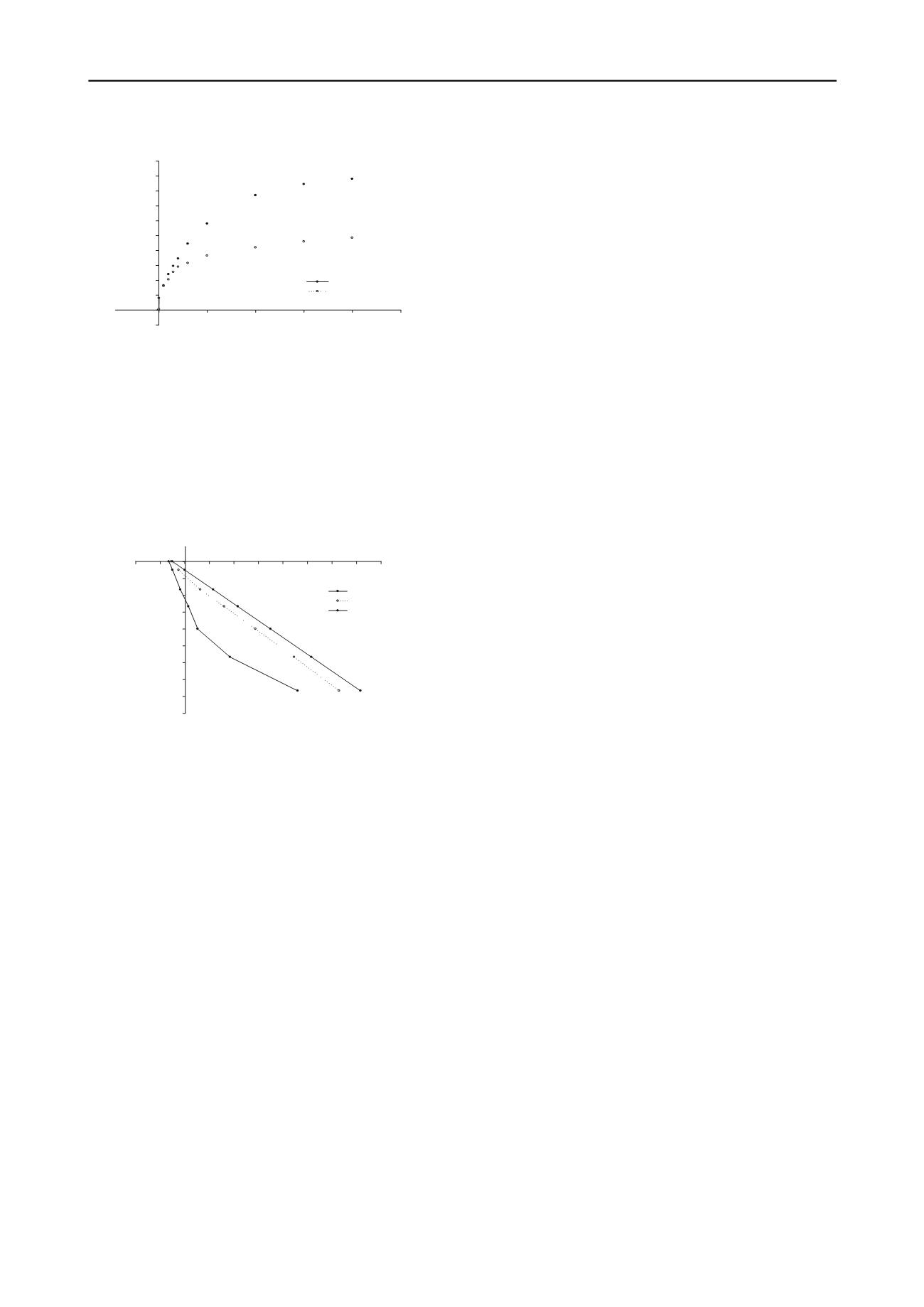
2130
Proceedings of the 18
th
International Conference on Soil Mechanics and Geotechnical Engineering, Paris 2013
Bobet, A. & Nam, S.W. 2007. Stresses around pressure tunnels with
semi-permeable liners. Rock Mechanics and Rock Engineering, 40,
(3) 287-315.
Pile gap to diameter ratio (x/d)
0.0
0.5
1.0
1.5
2.0
2.5
Normalisedsettlement(S/S
0
)
0.8
1.0
1.2
1.4
1.6
1.8
2.0
2.2
2.4
2.6
2.8
3.0
Estimated
Numerical
BSI 2004, Eurocode 7: Geotechnical design Part 1, General Rules.
EN1997-1:2004, British Standard Institution.
Carder, D.R., Watson, G.V.R., Chandler, R.J., & Powrie, W. 1999.
Long-term performance of an embedded retaining wall with a
stabilizing base slab. Proceedings of the Institution of Civil
Engineers-Geotechnical Engineering, 137, (2) 63-74.
Clark, J. 2006. Performance of a propped retaining wall at the Channel
Tunnel Rail Link, Ashford. PhD University of Southampton.
Day, R.A. & Potts, D.M. 1993. Modeling Sheet Pile Retaining Walls.
Computers and Geotechnics, 15, (3) 125-143
Figure 9. Comparison of analytical and numerical solutions for surface
settlement variation with x/d.
Gaba, A.R., Simpson, B., Beadman, D.R., & Powrie, W. 2003.
Embedded retaining walls: guidance for economic design.
Proceedings of the Institution of Civil Engineers-Geotechnical
Engineering, 156, (1) 13-15.
Hubbard, H.W., Potts, D.M., & Miller, D. 1984. Design of the retaining
walls for the M25 cut and cover tunnel at Bell Common.
Geotechnique, 34, (4) 495-512
2.5
Secant versus Contiguous Pile Retaining Walls
Comparisons were made between retaining walls formed of
contiguous and secant piles 20m long with 10m excavation
depth in homogeneous soil. Figure 10 shows that the pore
pressure profiles are slightly less than hydrostatic for the secant
and significantly less than hydrostatic for the contiguous pile
wall.
ITASCA. Fast Langrangian Analysis of Continua in 2 Dimensions. User
Manual. Itasca Consulting Group[7.0]. 2012. Minneapolis, USA.
Ref Type: Computer Program
Kolymbas, D. & Wagner, P. 2007. Groundwater ingress to tunnels - The
exact analytical solution. Tunnelling and Underground Space
Technology, 22, (1) 23-27.
Lee, I. M. & Nam, S. W. 2001, The study of seepage forces acting on
tunnel lining and tunnel face in shallow tunnels. Tunnelling and
Underground Space Technology, 16, (1) 31-40.
Pore pressure at the back of wall, kPa
-40 -20 0 20 40 60 80 100 120 140 160
Depthbelowground level (m)
-18
-16
-14
-12
-10
-8
-6
-4
-2
0
C0DB
S0DB
Hydrostatic
Lee, I. M. & Nam, S. W. 2006, Seepage Force Considerations in
Tunnelling, In International Symposium on Underground
Excavation and Tunnelling.
Potts, D. M., Axelsson, K., Grande, L., Schweiger, H., & Long, M.
Guidelines for the use of advanced numerical analysis. 2002.
Thomas Telford Publishing. Ref Type: Edited Book
Potts, D. M. & Burland, J. B. 1983,
Numerical investigation of retaining wall at Bell Common Tunnel.
Powrie, W., Chandler, R.J., Carder, D.R., & Watson, G.V.R. 1999.
Back-analysis of an embedded retaining wall with a stabilizing base
slab. Proceedings of the Institution of Civil Engineers-Geotechnical
Engineering, 137, (2) 75-86.
Figure 10. Comparison of pore pressure profiles for secant and
contiguous pile walls against hydrostatic pressure.
Richards, D.J., Powrie, W., Roscoe, H., & Clark, J. 2007. Pore water
pressure and horizontal stress changes measured during
construction of a contiguous bored pile multi-propped retaining
wall in Lower Cretaceous clays. Geotechnique, 57, (2) 197-205.
3 CONCLUSIONS
Limited research has previously been carried out on the
influence of retaining wall geometry on the development of
hydraulic loads on the active side. Numerical simulations
presented in this paper have shown that the pore pressure
magnitude behind bored pile retaining walls reduces with
increasing pile gap to diameter ratio, x/d. This reduction in
lateral loads however is accompanied by an increase surface
settlement. However, the potential benefits of allowing
through-wall seepage are likely to be greater than the
drawbacks.
Roberts, T.O.L., Roscoe, H., Powrie, W., & Butcher, D.J.E. 2007.
Controlling clay pore pressures for cut-and-cover tunnelling.
Proceedings of the Institution of Civil Engineers-Geotechnical
Engineering, 160, (4) 227-236.
Shin, J.H. 2010. Analytical and combined numerical methods
evaluating pore water pressure on tunnels. Geotechnique, 60, (2)
141-145.
Shin, J.H., Addenbrooke, T.I., & Potts, D.M. 2002. A numerical study
of the effect of groundwater movement on long-term tunnel
behaviour. Geotechnique, 52, (6) 391-403.
Yoo, C.S. 2005. Interaction between tunnelling and groundwater,
Numerical investigation using three dimensional stress pore
pressure coupled analysis.
Journal of Geotechnical and
Geoenvironmental Engineering, 131, )2= 497ß513.
4 ACKNOWLEDGEMENTS
Funding for this research was provided by the Engineering and
Physical Sciences Research Council, (EPSRC) grant number
EP/F063482.
5 REFERENCES
Arjnoi, P., Jeong, J.H., Kim, C.Y., & Park, K.H. 2009. Effect of
drainage conditions on porewater pressure distributions and lining
stresses in drained tunnels. Tunnelling and Underground Space
Technology, 24, (4) 376-389.
Atkinson, J.H. & Mair, R.J. 1983. Loads on Leaking and Watertight
Tunnel Linings, Sewers and Buried Pipes due to Groundwater.
Geotechnique, 33, (3) 341-344


